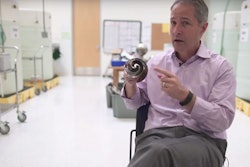Smart manufacturers don't look at safety as another thing to attend to. Instead, it's part of everything they do, and for good reason. Safe operations protect your most valuable assets — the people you work with.
When it comes to manufacturing, large operations with heavy machinery are the norm. Compared to other industries, rigorous safety planning should be of the highest priority.
Safe Work Environments
Machinery can be a major cause for hazard. Poorly maintained equipment can be dangerous to operators and other nearby equipment. Built-in fail-safes may offer piece-of-mind, but they're only designed as a last resort for "just-in-case" scenarios. There is no substitute for regular inspection and maintenance performed by trained professionals — whether in-house or contracted.
Machine staff are often your best resource for identifying problems. They work with the equipment every day and are often the first to notice any abnormal burning or electrical smells or grinding sounds. It's important that workers know to look for these signs, and that they know how to properly shut down the equipment if conditions are unsafe.
But there are many environmental concerns to consider in a manufacturing environment. Here are a few to keep track of on a regular basis:
Walking surfaces. Slips, trips and falls are the second leading cause of non-fatal work injuries leading to missed days of work. It's important to keep all walking areas clean, dry and free from obstruction. This means cleaning any spills or leaks as soon as possible, keeping aisles free from clutter and ensuring good condition of floor surfaces. Depending on surrounding plant conditions, certain floor materials, footwear or anti-slip mats may be beneficial. Elevated areas — including stairs, ladders and platforms — should receive special attention to ensure they are secure and equipped with solid guards and handrails.
Dust particles and air quality. Air quality can be a hazard for workers and equipment. Exhaust fumes and particles can cause respiratory problems. Dust accumulation can lead to fire or explosion if it accumulates on machine surfaces. Particles can also get into machines, increasing wear and potentially hurting product quality. If air quality is a concern in your environment, ensure the proper exhaust and circulation systems are in place. And, know the best way to remove dust accumulations when they occur. Vacuum or wet-cleaning methods are more effective than blowers that mostly re-suspend particles in the air.
Falling objects. Vertical storage is a convenient way to maximize the capacity of your facility, but it can pose a risk to workers below. Whenever there is activity above a workspace, ensure proper netting and toe boards are in place to prevent objects from falling. When stacking vertically, ensure heavier items are placed at the bottom for stability. The simplest precaution, however, is avoidance. If possible, don't store objects above workers.
Hazardous materials. It's common for manufactures to use hazardous materials in their operations — either as fuel or material input. Hazardous materials should have clear material data sheets readily available to inform safe use and handling. All materials and their containers should be clearly labelled, and there should be strict parameters for storage and disposal. Flammable substances in particular should be stored away from any combustion sources.
Fire hazards. Fire safety is a concern for any building and its occupants. With multiple heat sources and combustible materials readily on hand, manufacturing environments can be especially susceptible to fire. Make sure all sprinklers, extinguishers and smoke detectors are inspected regularly and are free from obstruction. All exits should be clearly marked. When dealing with flammable materials, be sure to keep them contained. Clothes, for example, should be changed if contaminated with flammable materials.
Confined spaces. A confined space is any space where oxygen can be depleted. Vats and storage tanks can trap someone and limit their ability to communicate with others. To prevent incidents, employees should work in pairs when dealing with confined spaces — with one person always beyond risk of entrapment.
In The Event Of An Accident
If an accident does occur, it's important to avoid jumping to conclusions as to what caused it. Be sure to determine all actions and events that took place leading up to and during the incident. What was happening nearby? Who was involved? What actions were taken?
Once a detailed account of the incident has been documented, consider the cause.
- Was there an unsafe act committed by someone who knowingly or un-knowingly didn't follow proper procedure?
- Was there a deficiency in the surrounding environment — in terms of safeguards, safety equipment, visibility or supervision?
- Do the established procedures take into account the hazards that contributed to the event?
- Were there personal factors — such as skill, training, fatigue, emotional distress or substance abuse — that could have affected the outcome?
Knowing the answers to these questions will help identify what interventions may be required.
Finally, in the event of an accident, employees may need additional support — especially if they suffered or witnessed significant trauma, such as an injury, fatality or near-miss. Recovery programs can support workers experiencing post-incident stress and help them return to work quicker with better morale.
Culture Of Safety
The people you work with are ultimately responsible for the safety of your environment. They are the ones operating the machinery beside you, taking care to put equipment and materials away when finishing tasks, and alerting you in the case of impending danger. Carelessness and complacency are your enemies here. Most accidents can be avoided by staying alert and staying vigilant.
To keep safety top of mind, a formal safety program will ensure proper attention and planning. Safety programs may include several aspects:
- A concise policy statement outlining the aims, priorities and responsibilities for both employees and employers
- Regular inspections to ensure safe and proper work conditions
- Written procedures that identify and explain potential hazards
- Assigned safety authorities who are made aware of all potential hazards or incidents
- Regular meetings or discussions to identify needs and to address them
- Proper training to ensure employees are kept up to date on new equipment and technology
- Documented inspection reports and action notes demonstrating implementations
The most in-depth planning will be for nought without strong leadership. Employees should see established procedures backed by actions, free from shortcuts and compromise. Employees should also be involved, as they bring real hands-on insight.
Brad Done is the vice president at Reliance Foundry Co Ltd. He has more than 25 years' experience with manufacturing in North America and overseas.






















